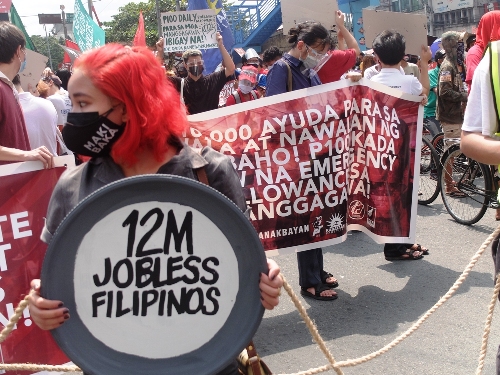Ayuda urgent: Jobs crisis still worse than before pandemic — IBON
Government claims of the employment situation improving in February 2021 compared to pre-pandemic January 2020 are unfounded, research group IBON said.
The so-called increase in employment is just Filipinos desperate to make a living in any way they can. This makes the need for substantial cash aid even more urgent, the group said.
The economic managers repeatedly claim that “we have surpassed our pre-pandemic employment level of 42.6 million in January 2020,” such as when the February 2021 labor force survey (LFS) results were released.
IBON said the LFS figures, however, clearly show that the jobs crisis existing even before the pandemic has only gotten worse upon the longest and harshest lockdowns in Southeast Asia.
Reported employment increased by 610,000, from 42.5 million in January 2020 to 43.2 million in February 2021. But this was far from enough for the labor force which grew by 2.4 million over that same period to 47.3 million, said the group, resulting in even greater unemployment.
IBON also noted that there are 12 million combined unemployed (4.2 million) and underemployed (7.9 million) Filipinos as of February 2021, which is much more than the 8.7 million in January 2020 (i.e. 2.4 million unemployed and 6.3 million underemployed).
The 1.8 million increase in unemployment in itself already indicates collapsing household incomes for millions of Filipino families, said the group.

The marginal increase in employment should not be seen as a sign of any improvement because it masks a serious deterioration in the quality of work in the country, IBON said. Even less than before, so-called employment is not enough to give Filipino families the regular and secure incomes they need to survive.
By class of workers, the number of wage and salary workers fell by over 1 million and of employers in family farms and businesses by 72,000 from widespread lockdown-driven business closures and retrenchments. These are down to 26.7 million and 930,000, respectively.
IBON noted that jobless Filipinos were apparently driven to “self-employment” which bloated by 1.4 million and to being “unpaid family workers” which rose by 356,000. These increased to 12.5 million and 3 million, respectively.
By hours worked, the number of full-time workers fell by 2.9 million to 25.9 million. Those working only part-time however increased by 3.2 million to 16.6 million, and those “with a job, not at work” by 325,000 to 657,000.
IBON stressed that tens of millions of Filipinos are going hungry, most of all from not having the money to buy food especially from the lack of work.
The Php10,000 emergency cash assistance being demanded is all the more urgent to immediately alleviate hunger. The inflation-adjusted official food threshold as of March 2021 for a family of five is Php2,133 per week in the National Capital Region (NCR) and Php1,905 per week on average for the Philippines.
The latest Php1,000 token cash aid is glaringly not even enough for food expenses, considering even that official food thresholds are ridiculously low to begin with, IBON said.
At the same time, a large fiscal stimulus is critical to arrest economic scarring, jump-start the economy, and genuinely improve employment on a wider scale, said the group. #
